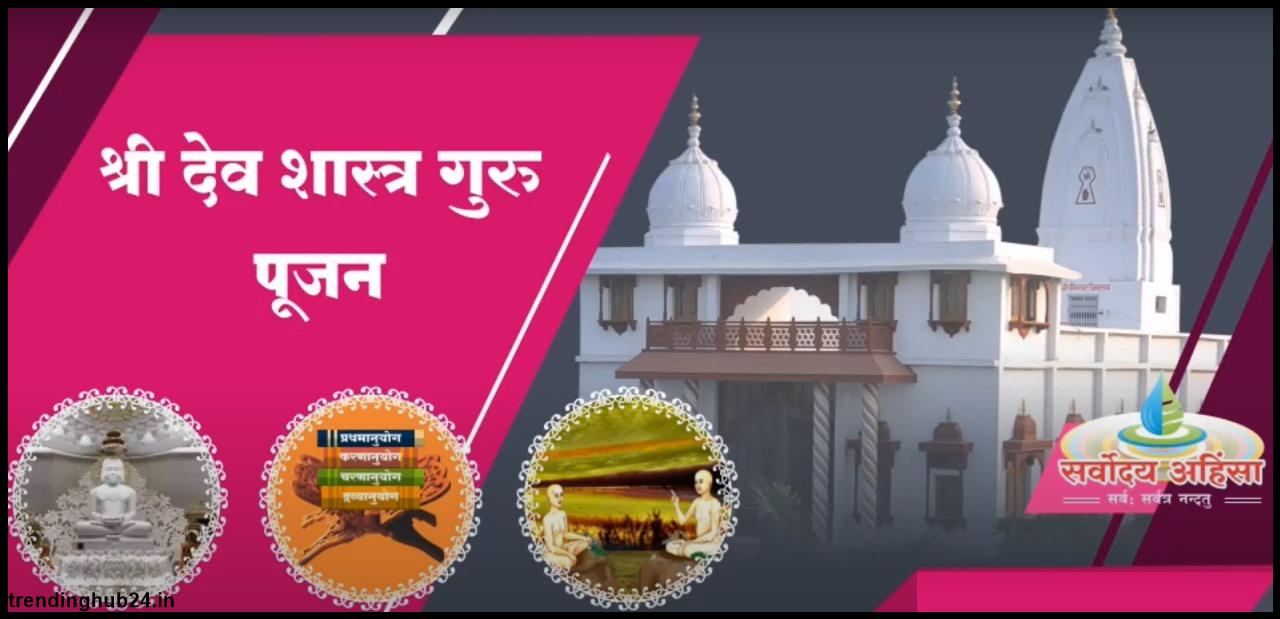🚀 Become a Verified Author on Trending Hub24
✍️ Author Account Available @ $60 / Month | +91 7355993756
Dev Shastra Guru Puja Full Vidhi and Mantras

You can do this puja at home or the temple, but chant proper mantras and follow appropriate steps for effective results.
Table of Contents
Dev Shastra Guru Puja: A warm welcome to the divine Intervention
In various Indian spiritual and religious activities, Dev Shastra Guru Puja is a greater form of tradition of the Divine (Dev), the texts (Shastra), and the instructor (Guru). This trio is about wisdom. Since Indians are well known for their knowledge and the way they worship knowledge, divinity you need to know a lot about how Dev Shastra Guru Puja's practices and importance:
Things to note when performing Dev Shastra Guru Puja
The most important ritual for Jains is Dev Puja. Typically, puja is performed with an idol present, and offerings are made. It is also known as Dravya Puja. However, it can be performed without an idol or material offerings (Bhav Puja). Puja can be done at home with or without an idol; however, it is often conducted in front of an Arihanta deity in a temple.
Bathing and changing into clean clothes, usually kept at the temple, are prerequisites for entering the temple. It is imperative to exercise extreme caution when visiting the temple to ensure that no living thing is damaged by carelessness. One must wash one's hands and feet before entering the temple.
To get the attention of the Devas and those in the vicinity, gently ring the bells as soon as you reach the temple hall.
You ought to recite as you approach the temple:
· Nisshai, Nisshai, Nisshai
· Om Jai Jai Jai
· Namostu, Namostu,Namostu
Next, you submit yourself before the idol and repeat the Namokar Mantra three times. Next, you make three rounds of the vedi (alter) in a clockwise direction. Then, for Puja, you enter the Gabharo.
How is Shastra Puja performed?
Abhishek:
Abhishek is the term for bathing the idol, and pure water is typically used.
On certain days, people perform the Panchamrut Abhishek, which involves Dravyas such as ghee, milk, curd, sandal water, and water.
Nevertheless, milk and its derivatives should not be used in puja due to the modern methods of obtaining milk.
Eliminating negative thoughts from one's mind is Abhishek's primary goal. It also maintains the idol's cleanliness.
Using fresh clothes, the idol is dried after being bathed. You should chant the prayer "Prabhu Patit Pawan" at this time.
Puja-Parambh
People recite the Swasti Mangal Stotra throughout this process.
Main puja:
Eight materials are used for the major puja (Ashta dravya)
Jal Puja
This puja (Janma, Jara, Mrityu Vinashnaya) presents clean water to break free from the cycle of birth, aging, and death. All living things constantly experience the suffering of birth, life, and death.
Akshat Puja
The offering of white-washed rice without husk or akshat in this puja represents the end of the cycle of birth, life, and death (Akshay pad papaya). It is more similar to white rice and cannot be re-germinated.
Pushpa Puja:
Rice dyed with saffron or flowers is offered during this puja. A flower is a representation of passion and sensuality. Giving up all passions is the main source of karmic accumulation, symbolized by the flower offered (Kamvaan Vinashnaya). Instead of harvesting flowers, saffron-colored rice is typically used, which gives plants and insects hints.
Naivedya Puja
Naivedya denotes tasty cuisine. During this pooja, little white, uncolored coconut portions that symbolize delicious food are offered. The Puja performer wishes to lessen or eliminate the need for delicious food (Chuda Yog Vinasanaya). The ultimate goal in life is to reach Nirvana, which eliminates the need for any nourishment. Again, the Digamber sect utilizes chunks of coconut to avoid the violence involved in producing sweets.
Deepak Puja
A lamp (diya or Deepak) is offered during this puja to dispel the darkness of ignorance and untrue beliefs (Mohandhakar Vinashanaya). Typically, bits of coconut dyed with saffron symbolize lamps or Deepak because lamps' flames cause harm to airborne creatures.
Dhup Puja
During this ritual, sandal dust or cloves are donated as dhup. It meant to destroy all eight karmas (Ashtakaram Vinashnaya).
Fal Puja:
Fruit-representing shelled almonds or coconut are offered during this puja. Fruit represents Nirvana, also known as Moksha, which is the ultimate objective of all living things in the cosmos (Moksh fal pratapya). Again, to reduce any potential aggression when delivering fresh fruits, entire almonds or coconuts will be used.
Arghya Puja
Arghya is a combination of the eight puja substances (dravyas). When one does not have time to perform each of the eight dravya separately, anargha pad paraptaya, or arghya puja, is performed.
Jayamala (Adoration)
Reciting Tirthankar Bhagwan's attributes is part of this ceremony. As one recites his qualities, one is reminded that people's souls are blessed with comparable virtues and can reach Mokshaby by saying goodbye to karmas.
Shanti Paath
Praying for peace is wishing for happiness and peace for all living things. It is called Shanti Paath.
The Visarjan
The puja ends with this rite. During Visarjan, a prayer is offered to all the celestial creatures present during the puja. This prayer will request celestial creatures to return to their proper places and to pardon any carelessness or mistakes made during the puja.
Aarti
To conclude the puja, the Aarti of Panch Parmeshti or Tirthankar is recited.
Final words:
Praying to God is better when you are out of your mind or lost in the course of actions. To attain peace in your mind, start your prayer now with the above-mentioned points. You can do this puja at home or the temple, but chant proper mantras and follow appropriate steps for effective results.
